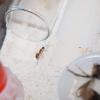Hey folks,
I'm looking for advice about what sort of animal life I could incorporate into a bioactive vivarium. I've currently got a growing colony of Camponotus -- with around 500 workers, I think -- in a 3 gallon vivarium. They've done quite well thus far, and will be needing a bigger enclosure soon. I have some cleanup crew critters in there: dwarf isopods, grindal worms, two kinds of springtail, booklice, and even some miniature roaches. But I'm thinking to make their next setup at least 3x as big: a 10-16 gallon long like this or this. I figure that in a vivarium of that size it might be nice to bring some other organisms into the mix, and I'm wondering if anyone has ideas/suggestions.
I'm looking for something that won't eat the ants -- or at least, not many of them -- and that also isn't vulnerable to harassment by them. I reckon that an enclosure of this size probably isn't big enough to comfortably house, say, an amphibian/reptile and the ants, but maybe there's some larger invert that could hack it. Despite being pretty gregarious, the ants don't usually do anything more than feebly chase the largest other invert in their current setup, the roaches. They don't seem to be effective predators of anything more formidable than flightless fruit flies, so I'm hoping there's something that could co-habitate with them and not get too fussed by their perennial presence. Bonus points if it's interesting or fun to watch.
I've also thought about the multiple-species-of-ants angle, because folks like Nordic Ants have done it with much success; but I think I'd want to make a much larger vivarium before I risk the lives of any of my colonies on it.
Anyway, thanks in advance for any insight.
























